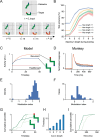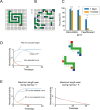Recurrent neural networks that learn multi-step visual routines with reinforcement learning
- PMID: 38683837
- PMCID: PMC11081502
- DOI: 10.1371/journal.pcbi.1012030
Recurrent neural networks that learn multi-step visual routines with reinforcement learning
Abstract
Many cognitive problems can be decomposed into series of subproblems that are solved sequentially by the brain. When subproblems are solved, relevant intermediate results need to be stored by neurons and propagated to the next subproblem, until the overarching goal has been completed. We will here consider visual tasks, which can be decomposed into sequences of elemental visual operations. Experimental evidence suggests that intermediate results of the elemental operations are stored in working memory as an enhancement of neural activity in the visual cortex. The focus of enhanced activity is then available for subsequent operations to act upon. The main question at stake is how the elemental operations and their sequencing can emerge in neural networks that are trained with only rewards, in a reinforcement learning setting. We here propose a new recurrent neural network architecture that can learn composite visual tasks that require the application of successive elemental operations. Specifically, we selected three tasks for which electrophysiological recordings of monkeys' visual cortex are available. To train the networks, we used RELEARNN, a biologically plausible four-factor Hebbian learning rule, which is local both in time and space. We report that networks learn elemental operations, such as contour grouping and visual search, and execute sequences of operations, solely based on the characteristics of the visual stimuli and the reward structure of a task. After training was completed, the activity of the units of the neural network elicited by behaviorally relevant image items was stronger than that elicited by irrelevant ones, just as has been observed in the visual cortex of monkeys solving the same tasks. Relevant information that needed to be exchanged between subroutines was maintained as a focus of enhanced activity and passed on to the subsequent subroutines. Our results demonstrate how a biologically plausible learning rule can train a recurrent neural network on multistep visual tasks.
Copyright: © 2024 Mollard et al. This is an open access article distributed under the terms of the Creative Commons Attribution License, which permits unrestricted use, distribution, and reproduction in any medium, provided the original author and source are credited.
Conflict of interest statement
The authors have declared that no competing interests exist.
Figures








Similar articles
-
Reinforcement Learning of Linking and Tracing Contours in Recurrent Neural Networks.PLoS Comput Biol. 2015 Oct 23;11(10):e1004489. doi: 10.1371/journal.pcbi.1004489. eCollection 2015 Oct. PLoS Comput Biol. 2015. PMID: 26496502 Free PMC article.
-
Flexible Working Memory Through Selective Gating and Attentional Tagging.Neural Comput. 2021 Jan;33(1):1-40. doi: 10.1162/neco_a_01339. Epub 2020 Oct 20. Neural Comput. 2021. PMID: 33080159
-
Pruning recurrent neural networks replicates adolescent changes in working memory and reinforcement learning.Proc Natl Acad Sci U S A. 2022 May 31;119(22):e2121331119. doi: 10.1073/pnas.2121331119. Epub 2022 May 27. Proc Natl Acad Sci U S A. 2022. PMID: 35622896 Free PMC article.
-
Beyond the feedforward sweep: feedback computations in the visual cortex.Ann N Y Acad Sci. 2020 Mar;1464(1):222-241. doi: 10.1111/nyas.14320. Epub 2020 Feb 28. Ann N Y Acad Sci. 2020. PMID: 32112444 Free PMC article. Review.
-
Early Visual Cortex as a Multiscale Cognitive Blackboard.Annu Rev Vis Sci. 2016 Oct 14;2:131-151. doi: 10.1146/annurev-vision-111815-114443. Epub 2016 Jul 18. Annu Rev Vis Sci. 2016. PMID: 28532363 Review.
Cited by
-
A model of thalamo-cortical interaction for incremental binding in mental contour-tracing.PLoS Comput Biol. 2025 May 8;21(5):e1012835. doi: 10.1371/journal.pcbi.1012835. eCollection 2025 May. PLoS Comput Biol. 2025. PMID: 40338986 Free PMC article.
References
-
- Horswill I. Visual routines and visual search: a real-time implementation and an automata-theoretic analysis.
Publication types
MeSH terms
LinkOut - more resources
Full Text Sources

